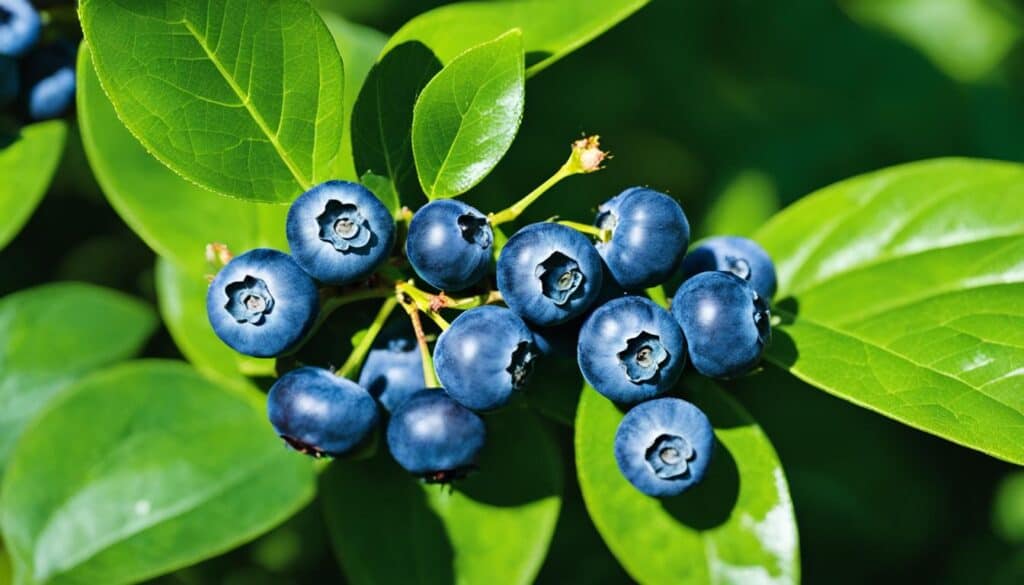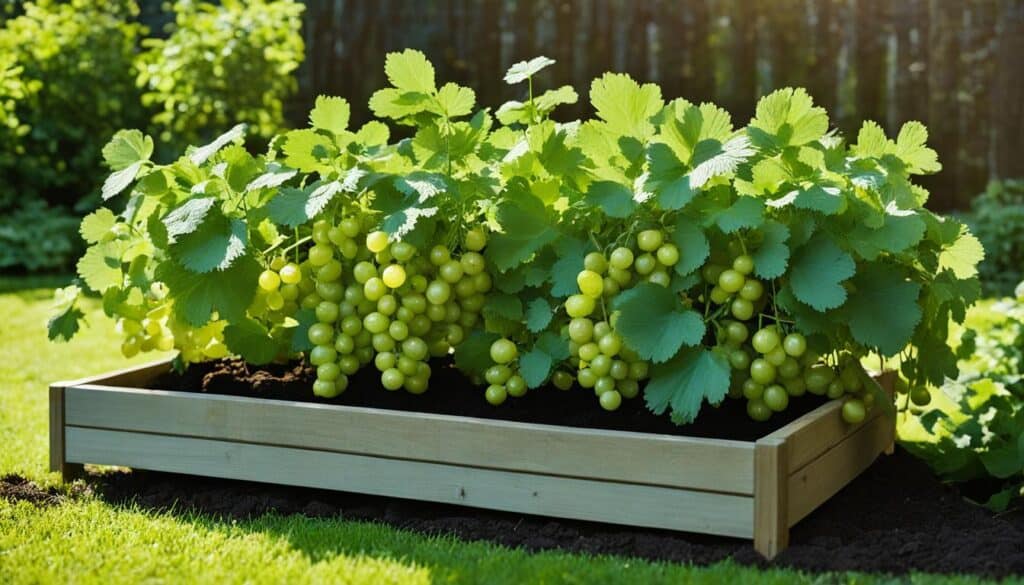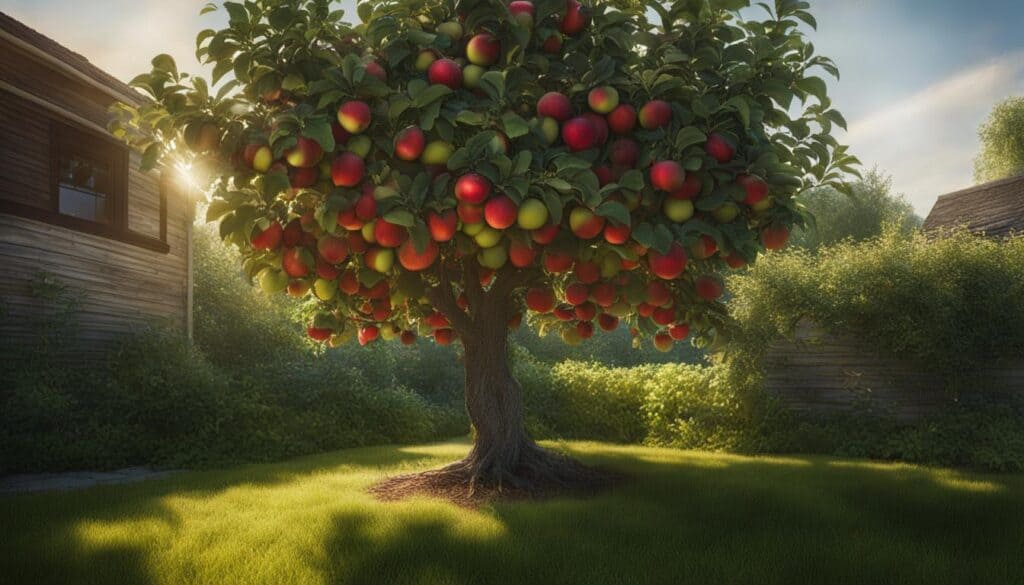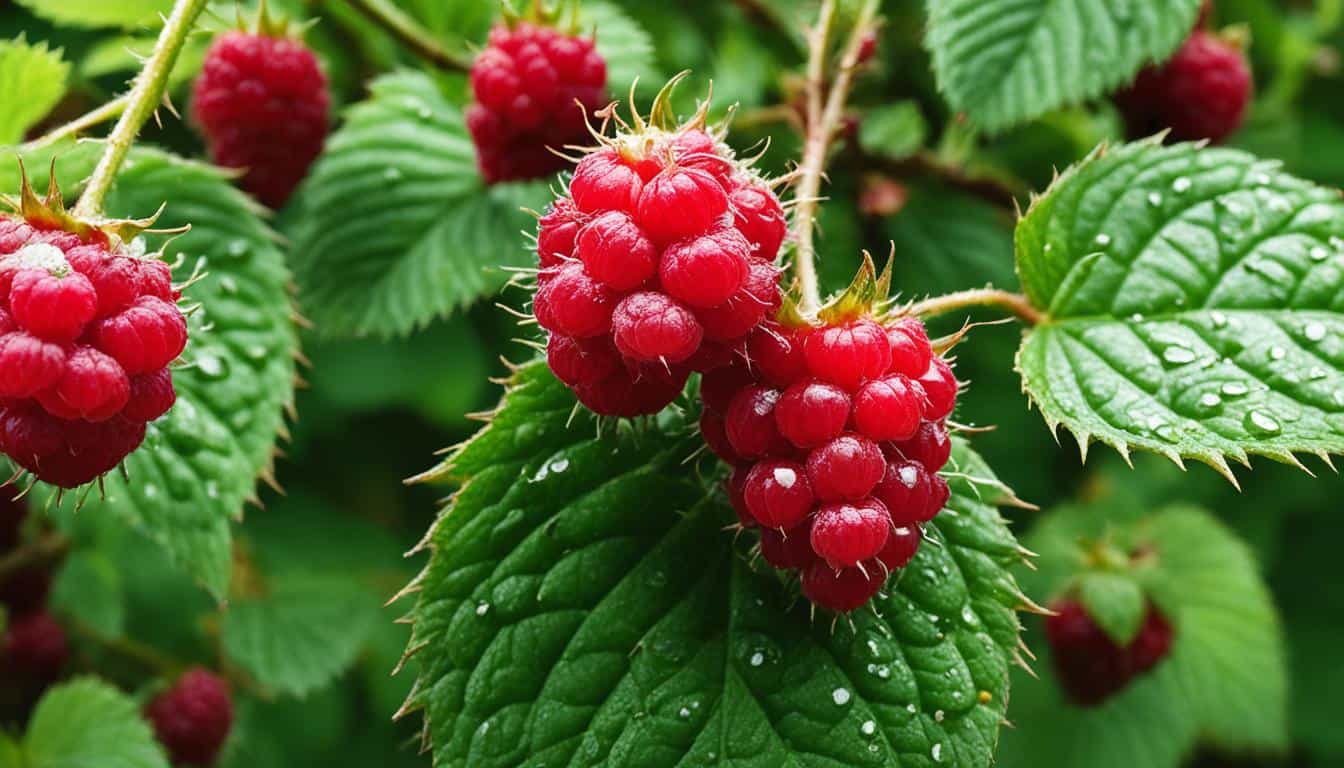Growing your own fruit at home doesn’t have to be daunting or complicated. There are several fruits that are perfect for beginners and require minimal effort and maintenance. Let’s explore the easiest fruit to grow for beginners at home.
When it comes to easy-to-grow fruits, there are plenty of options that are beginner-friendly. Whether you have a small garden, a patio, or even just a sunny windowsill, you can enjoy the satisfaction of growing your own fresh and delicious fruits.
So, what fruit is easiest to grow? Let’s take a look at some of the top contenders that are low maintenance and perfect for beginners:
Key Takeaways:
- Strawberries are simple to grow and can thrive in containers, hanging baskets, or directly in the ground.
- Raspberries are abundant and can be planted in raised beds, containers, or in the ground, offering a longer harvesting season.
- Blueberries are nutrient-dense and can be grown in containers, adding beauty to your patio or garden.
- Figs bring a taste of the Mediterranean and are surprisingly easy to grow, especially when planted against a sunny wall.
- Gooseberries require very little maintenance and are versatile in culinary uses.
Strawberries – Simple and Versatile
Strawberries are one of the easiest fruits to grow, making them ideal for beginners. They can thrive in containers, hanging baskets, window boxes, or directly in the ground. Strawberries require a sunny position and well-drained soil to thrive. There are various strawberry varieties that are suitable for different growing conditions and seasons.
One popular strawberry variety is the June-bearing strawberry. These strawberries produce a single large crop in late spring or early summer. Another option is the Everbearing strawberry, which produces multiple smaller crops throughout the growing season, making it a great choice for continuous harvest.
To grow strawberries, start by selecting healthy plants from a reputable supplier. Plant them in fertile soil, enriched with organic matter. Ensure the plants receive adequate water and are protected from pests and diseases. Regularly remove weeds and provide support for the fruit-laden plants to prevent them from touching the ground.
Pro Tip: To maximize strawberry production, consider using strawberry planters or raised beds. These provide better drainage and help prevent diseases.
Benefits of Growing Strawberries
Growing strawberries offers several benefits for beginner fruit growers:
- Easy Maintenance: Strawberries are low maintenance fruit plants, requiring minimal care compared to other fruits. They are also relatively pest and disease resistant.
- Bountiful Harvest: With proper care, strawberry plants can produce abundant fruit, providing a satisfying and rewarding harvest.
- Versatility: Strawberries can be enjoyed in various ways, such as fresh, in jams, pies, or desserts. Their sweet flavor and vibrant color make them a versatile ingredient in the kitchen.
- Great for Small Spaces: Since strawberries can be grown in containers, they are suitable for balcony gardens, small yards, or even window boxes.
Whether you want to enjoy freshly picked strawberries or explore your culinary creativity, growing strawberries is a rewarding and straightforward fruit cultivation experience.
Raspberries – Abundant and Delicious
Raspberries are a fantastic fruit that beginners will love growing. They are not only easy to grow but also produce abundant and delicious harvests. Whether you have a small raised bed, containers on your patio, or a spacious garden, raspberries can thrive in various settings. Here’s what you need to know about growing raspberries:
Planting Raspberries
When planting raspberries, choose a sunny location with well-drained soil. Raspberries prefer slightly acidic soil with a pH level between 5.5 and 6.5. Incorporating organic matter, such as compost or aged manure, can help improve the soil’s fertility and drainage.
Tip: Before planting raspberries, it’s crucial to remove any weeds or grass from the planting area to prevent competition for nutrients and water. Good soil preparation is key to the success of your raspberry plants.
You can start raspberries from bare-root plants or container-grown ones. Bare-root plants are usually available in late winter or early spring, while container-grown plants can be planted throughout the growing season. When planting, ensure that the crown of the raspberry plant is level with or slightly above the soil surface.
Choosing Raspberry Varieties
Raspberries come in different varieties, each with its unique characteristics and flavor profiles. The two main types of raspberries are summer-fruiting and autumn-fruiting varieties.
- Summer-Fruiting Raspberries: These varieties produce fruit on second-year canes (primocanes) that grow in the first year. They typically bear fruit from mid to late summer.
- Autumn-Fruiting (Everbearing) Raspberries: These varieties produce fruit on first-year canes (primocanes) that grow in the current year. They usually bear fruit in late summer or early fall.
Tip: If you choose both summer-fruiting and autumn-fruiting raspberry varieties, you can enjoy a longer harvesting season and a continuous supply of fresh raspberries.
Pruning Raspberries
Proper pruning is essential for maintaining healthy and productive raspberry plants. Pruning helps manage the size of the plants, remove old canes, improve airflow, and promote better fruiting.
- Summer-Fruiting Raspberries: Prune these raspberries immediately after harvest. Remove the old canes that have borne fruit, leaving the new canes for the following year’s fruit production.
- Autumn-Fruiting Raspberries: Prune these raspberries in late winter or early spring. Cut all canes back to ground level, as the fruit will grow on the new canes that emerge during the current year.
By following the right pruning techniques, you can ensure that your raspberry plants remain healthy and productive for years to come.
Achieving Success with Raspberries
Raspberries are relatively low-maintenance once established. However, there are a few essential care practices to keep in mind:
- Watering: Raspberries require consistent moisture, especially during dry periods. Water deeply and avoid overwatering to prevent root rot.
- Fertilizing: Apply a balanced fertilizer in early spring to promote healthy growth. Avoid over-fertilizing, as this can result in excessive foliage growth and reduced fruit production.
- Weeding: Regularly remove weeds around the raspberry plants to minimize competition for nutrients.
- Support: Depending on the raspberry variety, providing support such as trellises, stakes, or a wire framework can help keep the plants upright and make harvesting easier.
With the right care and attention, your raspberry plants will reward you with an abundance of juicy and flavorful berries.
| Variety | Harvesting Season | Flavor |
|---|---|---|
| Tulameen | Mid-Summer | Sweet and Tart |
| Autumn Bliss | Late Summer-Early Fall | Sweet and Juicy |
| Heritage | Late Summer-Early Fall | Intense and Tart |
| Caroline | Mid to Late Summer | Sweet and Rich |
Blueberries – Nutrient-Dense and Colorful
Blueberries are not only delicious but also packed with nutrients. They are considered one of the easiest fruits to grow, making them perfect for beginners. These low maintenance fruit plants can thrive in containers, adding a beautiful touch to any patio or garden with their scented spring flowers and colorful autumn foliage.
What makes blueberries a great choice for uncomplicated fruit plants is their adaptability to various growing conditions. They can tolerate both acidic and alkaline soil, although they prefer acidic soil with a pH range of 4.0 to 5.5. If your soil is not naturally acidic, you can achieve the desired pH by using ericaceous compost. Blueberries also require well-drained soil to prevent waterlogging and root rot.
Easy Steps to Growing Blueberries:
- Choose a sunny spot for your blueberry plants, as they require at least 6 to 8 hours of direct sunlight daily.
- Prepare the soil by adding organic matter, such as compost or well-rotted manure, to improve its fertility and drainage.
- Dig a hole that is twice the width and depth of the plant’s root ball. Gently place the blueberry plant in the hole, making sure the top of the root ball is level with the surrounding soil.
- Backfill the hole with soil, firming it gently around the plant’s base.
- Water the newly planted blueberry thoroughly to settle the soil and promote root establishment.
- Mulch around the base of the plant with a layer of organic mulch, such as wood chips or straw, to conserve moisture and suppress weeds.
- Regularly water your blueberry plants to keep the soil consistently moist, especially during dry spells.
- Prune the blueberry bushes during the dormant season to maintain their shape and remove any dead or diseased branches.
- Fertilize your blueberry plants with a balanced fertilizer formulated specifically for acid-loving plants, following the manufacturer’s instructions.
Choosing self-fertile blueberry varieties, such as ‘Bluecrop,’ ‘Bluegold,’ or ‘Jersey,’ eliminates the need for cross-pollination and makes it even easier for beginners to grow a successful blueberry harvest. Remember, it may take a year or two for your blueberry plants to establish and start producing a reliable crop, but the wait is worth it.
Now that you know how easy it is to grow blueberries, you can enjoy their delicious taste and reap the health benefits of these nutrient-dense fruits right in your own garden.

Figs – A Taste of the Mediterranean
Fig trees bring a taste of the Mediterranean to your garden and are surprisingly easy to grow. They love sunshine and warmth, so planting them against a hot, sunny wall is ideal. Fig trees also do well in containers, making them suitable for small gardens. With proper protection from frost, fig trees can provide a bountiful harvest of delicious, sun-warmed fruits.
Why Choose Fig Trees?
Figs, known for their unique flavor and soft, sweet flesh, are a delightful addition to any fruit garden. They are relatively low maintenance, making them perfect for beginners. Here are some reasons why fig trees are a great choice:
- Easy to grow: Fig trees are known for their resilience and adaptability. They can thrive in various climates and soil conditions, making them suitable for different regions.
- Low maintenance: Once established, fig trees require minimal care. They are drought-tolerant and have few pest or disease issues.
- Abundant harvest: With the right conditions, fig trees can produce a plentiful harvest. Depending on the variety, you can enjoy one or two crops per year.
- Versatile uses: Figs can be enjoyed fresh, dried, or used in a variety of culinary creations, including desserts, salads, or jams.
I love growing fig trees in my own backyard. The sight of those ripe, juicy fruits hanging from the branches never fails to excite me. Plus, the delicious taste of sun-ripened figs is unparalleled. It’s like a piece of the Mediterranean right at home.
Recommended Fig Varieties for Beginners
When choosing fig trees for your garden, consider these beginner-friendly varieties:
| Variety | Description |
|---|---|
| Brown Turkey | A popular and reliable variety with sweet, purplish-brown fruit. It is relatively cold-hardy and can produce two crops per year. |
| Black Mission | A classic fig with dark purple fruit and a rich, sweet flavor. It is adaptable to different climates and is known for its productivity. |
| Celeste | A smaller, heat-tolerant variety with medium-brown fruit. Its sweet and flavorful figs make it a favorite for fresh eating. |
Planting a fig tree in your garden or container is a rewarding experience. The effortless fruit tree cultivation and the delicious Mediterranean flavor it brings are hard to resist. Whether you enjoy figs fresh off the tree or incorporate them into your favorite recipes, fig trees are a fantastic addition to any fruit garden.
Gooseberries – Simple and Versatile
When it comes to easy-to-grow fruits, gooseberries are a top choice for beginners. Not only do they require very little maintenance, but they also thrive in shady areas that may be unproductive for other plants in your garden. Gooseberries are incredibly versatile and can be used in various culinary creations, making them a delightful addition to any fruit garden.
One of the best things about gooseberries is their suitability for baking. From adding them to cakes to making crumbles and pies, these versatile fruits lend a burst of tangy flavor to your favorite desserts. They can also be transformed into delicious jams and cordials, allowing you to enjoy their delightful taste all year round.
With the right variety of gooseberries, you’ll be rewarded with a long harvesting window. This means you can enjoy fresh gooseberries over an extended period and savor their unique taste. Whether you prefer to eat them straight from the bush or incorporate them into your favorite recipes, gooseberries are sure to become a staple in your fruit garden.

To give you a better idea of the potential harvest from gooseberries, here’s a table showcasing different varieties and their characteristics:
| Variety | Taste | Harvest Time |
|---|---|---|
| Invicta | Tart | Mid-July |
| Hinnonmaki Red | Sweet and tangy | Early July |
| Pixwell | Mild and sweet | Mid-June to July |
As you can see, there are different varieties of gooseberries available, each with its own unique taste and harvest time. This allows you to choose the perfect variety that suits your flavor preferences and ensures a fruitful harvest throughout the summer season.
Apples – Classic and Rewarding
When it comes to easy-to-grow fruits, apples are a classic choice that offers a rewarding experience for beginners. These versatile trees can produce fruit from mid-summer to late autumn, providing you with a bountiful harvest to enjoy.
To ensure successful apple cultivation, it’s important to choose the right variety and provide suitable growing conditions. Apple trees prefer fertile, well-drained soil and plenty of sunlight to thrive. With the proper care and maintenance, they can be relatively low-maintenance fruit plants.
For those with limited space, compact dwarf varieties are also available, making them a great option for small gardens or growing in containers. These dwarf apple trees can still produce a generous yield while taking up less space.
Benefits of Growing Apples:
- Easy to grow fruits, making them suitable for beginners
- Low maintenance fruit plants
- Beginner-friendly fruit trees
- Simple fruit cultivation
Whether you prefer to enjoy apples fresh from the tree, bake them into pies, or turn them into homemade applesauce, growing your own apples can be a fulfilling journey. With a little care and patience, you can experience the joy of harvesting delicious and nutritious apples right from your own backyard.
“Growing my own apples has been such a rewarding experience. There’s nothing quite like biting into a crisp, juicy apple that I grew myself. Plus, it’s been a great way to connect with nature and enjoy the satisfaction of nurturing a fruit tree.”

Blackberries – Prolific and Colorful
Blackberries are a fantastic choice for beginners looking to grow their own fruit. These delicious fruits are not only easy to grow but also require minimal attention to produce a bountiful crop. Whether you have a sunny garden or a shady spot, blackberries can thrive in various growing conditions, making them a versatile addition to your fruit garden.
One of the best things about blackberries is their versatility. You can enjoy them fresh off the plant or use them in a wide variety of desserts, jams, and jellies. Their rich, sweet flavor pairs perfectly with baked goods or as a topping for yogurt and ice cream.
If you have a small garden or limited space, worry not! Compact blackberry varieties are available, allowing you to grow these flavorful fruits even in hanging baskets. They can add an eye-catching touch to your patio or balcony.
Want to take a closer look at blackberries? Here’s a table summarizing their key characteristics:
| Characteristics | Description |
|---|---|
| Growing Difficulty | Easy |
| Maintenance Level | Low |
| Versatility | Can be eaten fresh or used in desserts and preserves |
| Preferred Growing Conditions | Thrive in both sun and shade |
Growing your own blackberries is a rewarding experience that requires little effort. Simply provide them with the right conditions, such as well-drained soil and regular watering, and watch them flourish. With their delicious taste and vibrant color, blackberries are sure to be a favorite in your fruit garden.

Honeyberries – Unusual and Nutrient-Rich
When it comes to easy-to-grow fruits, honeyberries are a unique and nutritious option that you should consider. These unusual berries are packed with nutrients and boast a delightful sweetness that is sure to satisfy your taste buds. What makes honeyberries stand out is their ability to thrive with minimal attention, making them perfect for beginners looking for low-maintenance fruit plants.
To ensure a successful harvest, it is recommended to grow honeyberries in pairs. Cross-pollination between two plants significantly increases fruit set and yield. So, if you want to enjoy a bountiful harvest of these delectable berries, make sure to plant two honeyberry bushes together.
“Honeyberries are a unique addition to any fruit garden. Their vibrant flavor and high nutritional content make them a perfect choice for those looking to explore unconventional fruit options.” – Expert Gardener
One of the great advantages of honeyberries is their versatility in terms of growing options. They can be planted in flower beds or containers, making them suitable for any garden size or space limitations. Honeyberries also boast an attractive appearance with their elongated blueberry-like shape, making them a visually appealing addition to your garden.
Now that you know about the unique qualities of honeyberries, why not experiment with these nutrient-rich fruits in your own garden? Whether you’re a seasoned gardener or just starting out, honeyberries are a fantastic choice that will reward you with abundant, delicious berries.
Take a look at the beautiful honeyberries below:
| Honeyberry Variety | Description |
|---|---|
| Aurora | Aurora honeyberries are known for their exceptional flavor, striking blue color, and high productivity. They are perfect for fresh eating or adding a unique touch to pies and jams. |
| Cinderella | Cinderella honeyberries are prized for their large size, firm texture, and sweet taste. These berries are wonderful for snacking or incorporating into various culinary creations. |
| Blue Banana | Blue Banana honeyberries are loved for their elongated shape and intense blue color. They have a rich, tangy flavor that adds a unique twist to smoothies, desserts, and salads. |
With their unusual flavors and nutritional benefits, honeyberries are a hidden gem in the world of fruits. Explore their unique qualities and enjoy the rewards of growing these amazing berries in your own backyard.
Goji Berries – Hardy and Nutritious
When it comes to easy-to-grow fruits that are perfect for beginners, goji berries are a top choice. These vibrant and nutritious berries thrive even in challenging growing conditions, making them ideal for windy or coastal areas. With their hardy nature and tolerance to salt, goji berries are low maintenance fruit plants that can withstand tough climates.
If you’re a beginner looking for straightforward fruit cultivation, goji berries are a great option. They prefer a sunny spot and benefit from being planted against a south-facing wall for optimal growth. By positioning them in the right conditions, you can ensure that your goji berry plants receive the necessary sunlight and warmth to thrive.
One of the key advantages of growing goji berries is their nutritional value. These berries are packed with vitamins and nutrients, making them a healthy addition to your diet. Whether you use them in smoothies, salads, or enjoy them fresh, goji berries provide a tasty and nutritious boost.
With goji berries, you can embark on a rewarding fruit-growing journey with confidence. Their hardiness, low maintenance nature, and nutritional benefits make them an excellent choice for beginner-friendly fruit trees. Start cultivating your own goji berries and enjoy their vibrant color and healthful properties!
Conclusion
Growing your own fruit can be a rewarding and enjoyable experience, especially for beginners like you and me. With a variety of easy-to-grow fruits available, you can create a hassle-free fruit garden that yields delicious produce with minimal effort.
By choosing beginner-friendly fruit trees such as strawberries, raspberries, blueberries, figs, gooseberries, apples, blackberries, honeyberries, goji berries, and more, you can embark on a journey of quick-growing fruit varieties. These fruits are known for their adaptability and low maintenance, making them perfect for novice gardeners.
Remember to provide the necessary growing conditions, like well-drained soil and proper sunlight, for your fruit trees to thrive. Regular pruning and maintenance will ensure optimal results and a bountiful harvest. So, roll up your sleeves and enjoy the satisfaction of growing your own fruit with ease!
FAQ
What are the easiest fruits to grow for beginners at home?
Strawberries, raspberries, blueberries, figs, gooseberries, apples, blackberries, honeyberries, and goji berries are some of the easiest fruits to grow for beginners at home.
Can strawberries be grown in containers?
Yes, strawberries can thrive in containers, hanging baskets, window boxes, or directly in the ground.
Do raspberries require pruning?
Yes, proper pruning is essential to ensure a healthy and productive raspberry plant.
How do I provide acidic soil for blueberries?
Blueberries require acidic soil, which can be achieved by using ericaceous compost.
Where is the best place to plant fig trees?
Fig trees love sunshine and warmth, so planting them against a hot, sunny wall is ideal. They also do well in containers.
Are gooseberries suitable for shady areas?
Yes, gooseberries can be grown in shady and unproductive areas of your garden.
Do apple trees need a lot of maintenance?
Apple trees are relatively low-maintenance, but they prefer fertile, well-drained soil and plenty of sunlight to thrive.
Can blackberries be grown in hanging baskets?
Yes, blackberries are versatile in growing conditions and can be grown in both sun and shade, including hanging baskets.
What growing conditions do honeyberries require?
Honeyberries are tough and hardy plants that require very little attention. They can be planted in flower beds or containers.
Are goji berries suitable for challenging growing conditions?
Yes, goji berries are fairly hardy and tolerant of salt, making them suitable for windy or coastal areas.





Leave a Reply